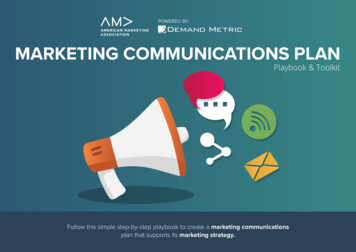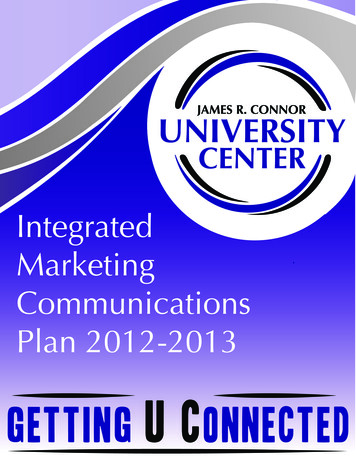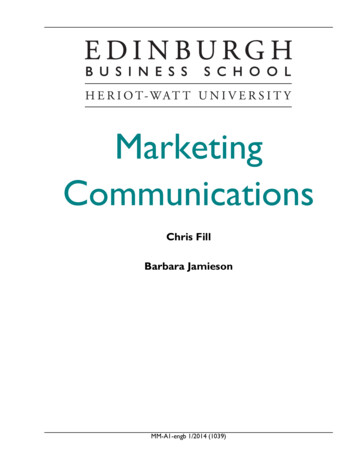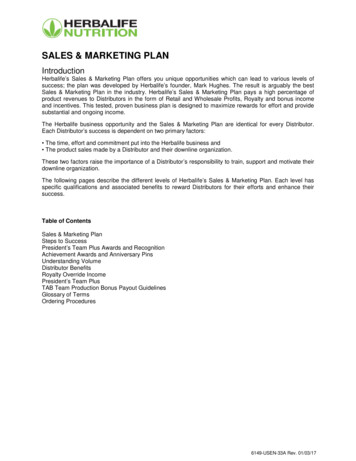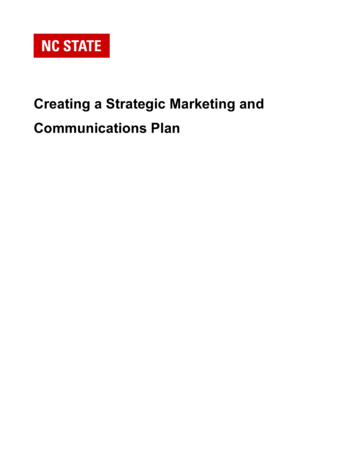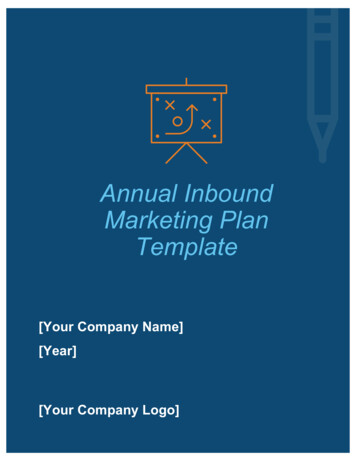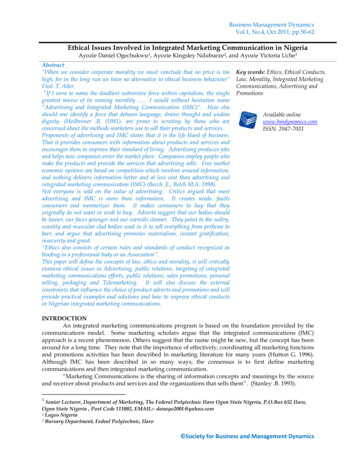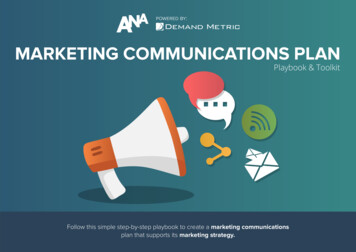
Transcription
MARKETING COMMUNICATIONS PLANPlaybook & ToolkitFollow this simple step-by-step playbook to create a marketing communicationsplan that supports its marketing strategy.
Table of ContentsMARKETING COMMUNICATIONS ge4stage5stage6Strategy & udget & Measurement10131621Conclusion24About This Playbook25
MARCOM PLANFrameworkClick the buttons below to access all relatedtraining, tools, templates, and other resources.Leverage the framework below to quickly empoweryour organization’s marketing communications strategy.1 STRATEGY2 AUDIENCE3 OBJECTIVES4 MESSAGES5 CHANNELS6 MEASUREMarketing StrategyPlanProductMarketing PlanMarketing StrategyScorecardPositioningStatement WorksheetMarketing ChannelRanking ToolBudget TemplateBrand AssessmentToolCustomer ProfileTemplateObjectives WorksheetMessageMapping ToolCampaign ImpressionCalculatorMarCom CalendarIndustry Analysis ToolTradeshowEvaluation MatrixKey MarketingMetrics DashboardCompetitor AnalysisToolEvents DatabaseTemplateCompetitive PR andAdvertising AnalysisSocial Media ChannelSelection ToolSocial Media PostingCalendarPress ReleaseTemplatePublic RelationsCalendarWeb Content AuditToolMobile MarketingMaturity AssessmentAdvertisementEvaluation Matrix
123456Strategy et &MeasurementIntroductionWhat Is the Purpose of This Playbook?How to Use This Consulting PlaybookTo help you develop a marketing communications plan that:This playbook consists of six stages, each with a description, steps,and action items. Action items include using our premium tools andtemplates. Our intention with this playbook is to help you:Is guided by the corporate marketing strategySupports individual product-marketing plansAchieves your awareness and promotion goals.Your marketing communications plan directs how you will communicate with various audiences: employees, clients, media, and others.Align your marketing communications with yourmarketing strategy and positioningCorporate Marketing StrategyOptimize your marketing communications for youraudience and each communications channelProduct AProduct BMarketing PlanMarketing PlanExecute & Measure your plan using our planning,scheduling, and tracking toolsMarketing Communications PlanMARKETING COMMUNICATIONS PLAN4
123456Strategy et &MeasurementIntroductionWhat Is a Marketing Communications Plan?Marketing communications (MarCom) plans are often called marketingplans or marketing strategies.Demand Metric believes the MarCom plan is separate and supportsthe marketing strategy and individual product-marketing plans.The marketing strategy traditionally is more strategic in nature andbroader in scope, covering the classic four Ps of the marketing mix:Outputs from This PlaybookStage 1 - Strategy & EnvironmentEnvironmental AssessmentStage 2 - AudienceAudience Understanding, Customer ProfilesStage 3 - ObjectivesMarCom Plan ObjectivesProductPlaceStage 4 - MessagesKey MessagesPricePromotionThe MarCom plan is more tactical in nature and focuses primarily onPromotion.Stage 5 - ChannelsMarCom Channel Selection, Plan, and Schedule for EachChannelStage 6 - Budget & MeasurementConsolidated Budget, Master Calendar, MarComDashboardMARKETING COMMUNICATIONS PLAN5
MARKETING COMMUNICATIONS PLANSTAGE 1Strategic DirectionBegin the creation of your MarCom plan by reviewing corporate marketing strategy. If no corporatemarketing strategy exists, Demand Metric recommends you develop one before attempting to createa MarCom plan. Use the Marketing Strategy Playbook as a guide for this strategic process.The goal of this stage is to ensure your MarCom plan supports the strategic direction of yourcompany. You’ll examine the overall marketing strategy and objectives, review or complete acompetitive analysis, and assess environmental influences.STEP 1: Marketing Strategy ReviewSTEP 2: Environmental Assessment
lsBudget &MeasurementStrategy &EnvironmentSTEP 1STEP 2Marketing Strategy ReviewEnvironmental AssessmentAction ItemAction ItemIf you have not developed a Marketing Strategy, do that firstbefore attempting to create your MarCom Plan. Use theMarketing Strategy Plan to do this.Understand where the company or brand has been, thecurrent position, where it needs to go, and how it will get there.Consider your external environment and assess the influences they will have on your MarCom plan:ConsiderationDemand Metric Tool or TemplateBrand AwarenessBrand Assessment ToolPolitical, Regulatoryand EconomicSTEP Industry Analysis ToolCompetitionCompetitor Analysis ToolMedia coverageCompetitive PR and AdvertisingAnalysisVIEW RESOURCERegardless of how your marketing strategy was developed, refer toit to get the context for developing your MarCom plan:What products or initiatives will your MarCom plan support?What core values or strategic objectives should influencethe development and content of the MarCom plan?What core competencies can you exploit or showcasethrough this MarCom plan?MARKETING COMMUNICATIONS PLAN7
MARKETING COMMUNICATIONS PLANSTAGE 2MarCom Plan AudienceDuring this stage you will identify all the audiences you need to reach with your MarCom plan.Common target audiences for a MarCom plan include customers, media, market & research,analysts, employees, industry thought leaders, and business partners.STEP 1: Audience IdentificationSTEP 2: Develop Personas
1Introduction2Strategy &Environment3456ObjectivesMessagesChannelsBudget &MeasurementAudienceSTEP 1STEP 2Audience IdentificationDevelop PersonasAction ItemAction ItemIdentify each audience your MarCom plan will address.“Audiences” are types of businesses or people that sharecommon characteristics (e.g. “Community Banks” or “ActiveSeniors”). You’re better served defining your audiences asnarrowly as possible.Create Personas, a hypothetical profiles, for each audienceyou’ve identified using the Customer Profile Template.VIEW RESOURCEVIEW RESOURCEPersonas will help you:If you are creating this MarCom plan to support a ProductMarketing Plan, refer to the market segments identified in thatplan to help identify and understand your audiences.Focus your communications on the needs of your audienceCreate messages for a specific person rather than a nebulous groupIdentifying and understanding your audiences helps you:Create messages specifically for each audienceUnderstand which communications channels and tactics canbest reach your audience with your messageHelpful Hint –If you are creating this MarCom planto support a Product Marketing Plan, refer to anyPersonas developed to support that plan.MARKETING COMMUNICATIONS PLAN9
MARKETING COMMUNICATIONS PLANSTAGE 3MarCom Plan ObjectivesYour MarCom plan objectives ideally are a subset of your marketingstrategy’s objectives and are specific to communications.In this stage, you will write your communications objectives for eachaudience you intend to reach through your MarCom plan.STEP 1: Marketing Strategy ObjectivesSTEP 2: Determine Your MarCom ObjectivesSTEP 3: State Your MarCom Objectives
Introduction12Strategy &EnvironmentAudience3456MessagesChannelsBudget &MeasurementObjectivesSTEP 1STEP 2Marketing Strategy ObjectivesDetermine Your MarCom ObjectivesAction ItemAction ItemReview your corporate Marketing Strategy ObjectivesScorecard to help frame the development of your MarComobjectives.MarCom plan objectives often fall into one of the followingcategories:Educate or informChange perceptionEnhance brand status or reputationVIEW RESOURCECreate sales leadsRecruit partners or employeesGenerate media coverageWhile business objectives are different from communications objectives, the latter should support the former. Regardless of how youdeveloped your marketing strategy, take time to understand how itshould direct the setting of your MarCom plan objectives.Based on what you know about your audience, determinea primary objective for your MarCom plan.Helpful Hint – If you used the Marketing Strategy Plan,refer to Stage 4.MARKETING COMMUNICATIONS PLAN11
Introduction12Strategy &EnvironmentAudience3456MessagesChannelsBudget &MeasurementObjectivesSTEP 3State Your MarCom ObjectivesAction ItemUse MarCom Objectives Worksheet to write your MarComplan objectives for each audience your plan will address,including each of the following elements:1. Target audience for the communications2. The desired or ideal response to these communications3. Indicators or measures of response4. The timeframe over which the communications shouldoccur and the response madeVIEW RESOURCEExample: To inform members of new services offerings providedby our company, so that at least half our members visit the new“Services” page on our website by the end of Q2 2012.MARKETING COMMUNICATIONS PLAN12
MARKETING COMMUNICATIONS PLANSTAGE 4Message CreationTo this point, you’ve determined the objectives and audience for your MarCom plan. During thisstage, you’ll create the messages that will serve as the building blocks for your plan. The messagesyou create provide information designed to get the audience to respond in some desirable way.Your messages are not the actual communications themselves, but summaries of what you wishto communicate. These messages will help you create your actual communications, which caninclude press releases, web content, ad copy, etc.STEP 1: Primary MessageSTEP 2: Message RefinementSTEP 3: Test Messages
Introduction123Strategy &EnvironmentAudienceObjectives456ChannelsBudget &MeasurementMessagesSTEP 1STEP 2Primary MessageMessage RefinementAction ItemAction ItemAuthor your primary message. As you do so, reference anyrelevant positioning information. If none exists, use thePositioning Statement Worksheet to develop it now.VIEW RESOURCEYour primary message articulates the main thing you need youraudiences to know and will:State what you’re doing and whyHave consistency with your MarCom plan objectivesAddress all identified audiencesUse the Message Mapping Tool to document the keymessages that are important for your target audience to hearabout your product.VIEW RESOURCEFor each identified audience, determine what each needs to knowthat is unique.For example, a media audience may need amplification of yourprimary message through a set of secondary messages in a differentway than your employee audience. Determine your secondarymessage requirements now and author them.MARKETING COMMUNICATIONS PLAN14
Introduction123Strategy &EnvironmentAudienceObjectives456ChannelsBudget &MeasurementMessagesSTEP 3Test MessagesAction ItemConduct some qualitative research, such as a focus group,to test the efficacy of your message(s). Use the free How-ToGuide Facilitating Insightful Focus Groups to help do this.FACILITATINGINSIGHTFULFOCUS GROUPSHow-to GuideVIEW RESOURCEBefore committing to the messages you’ve crafted as the foundation for your marketing communications, make sure they resonatewith your audience.You must have some assurance that your audience cares about themessages you desire to communicate.MARKETING COMMUNICATIONS PLAN15
MARKETING COMMUNICATIONS PLANSTAGE 5Channel SelectionWith Strategy, Audience, Objectives, and Messages determined, Stage 5 will lead you through theprocess of identifying the optimal channels for delivering your marketing communications.Few companies have the resources to fully exploit all possible marketing communications channels. Rather, they must be selective and base decisions on a set of criteria. During this stage, you’llidentify the optimal set of channels and schedule communications through them.STEP 1: Channel Evaluation & SelectionSTEP 2: EventsSTEP 3: Social MediaSTEP 4: Public RelationsSTEP 5: Web & OnlineSTEP 6: MobileSTEP 7: AdvertisingSTEP 8: Lead Generation
Introduction1234Strategy &EnvironmentAudienceObjectivesMessages56Budget &MeasurementChannelsSTEP 1STEP 2Channel Evaluation & SelectionEventsAction ItemAction ItemUse the Marketing Channel Ranking Tool to evaluate currentand planned MarCom channels. Based on this assessment, select the mix of channels you will use to support thisMarCom plan.If your channel mix includes Events:1. Use the Tradeshow Evaluation Matrix to assess youroptions2. Track all events and tradeshows using the EventsDatabase TemplateVIEW RESOURCEVIEW RESOURCESThe right mix rarely includes all possible channels, and usuallyincludes more than one. Use Brand Perception Effectiveness,Lead Generation Effectiveness, and Cost Effectiveness to assesshow well current and/or planned channels are performing.Helpful Hint – Use the Campaign Impression Calculatorto compare costs for each of these channels.MARKETING COMMUNICATIONS PLAN17
Introduction1234Strategy &EnvironmentAudienceObjectivesMessages56Budget &MeasurementChannelsSTEP 3STEP 4Social MediaPublic RelationsAction ItemAction ItemIf your channel mix includes Social Media:If your channel mix includes Public Relations:1. Use the Social Media Channel Selection Tool tonarrow your Social Media channel selections1. Properly write and format your Press Releases using thePress Release Template2. Schedule your communications through thesechannels using the Social Media Posting Calendar2. Schedule the issuing of your Press Release using thePublic Relations Calendar3. Track editorial opportunities using the EditorialCalendar TemplateMARKETING COMMUNICATIONS PLAN18
Introduction1234Strategy &EnvironmentAudienceObjectivesMessages56Budget &MeasurementChannelsSTEP 5STEP 6Web & OnlineMobileAction ItemAction ItemIf your channel mix includes Web & Online:If your channel mix includes Mobile:1. Determine what new or modified web content isrequired to support your MarCom plan1. If you have not yet exploited the Mobile channel, takethe Mobile Marketing Readiness Assessment2. Use the Web Content Audit Tool to help completeyour assessment2. Use the Mobile Marketing Channel Selection Tool tonarrow your mobile channel selectionsMARKETING COMMUNICATIONS PLAN19
Introduction1234Strategy &EnvironmentAudienceObjectivesMessages56Budget &MeasurementChannelsSTEP 7STEP 8AdvertisingLead GenerationAction ItemIf your channel mix includes Advertising:1. Use the Advertisement Evaluation Matrix to test theeffectiveness of your advertising concepts2. Use the Advertising Plan Checklist Template todevelop your advertising plan3. Schedule and track your plan using the AdvertisingCalendar & Budget TemplateAction ItemIf your channel mix includes Direct Marketing (e.g. email) forLead Generation:1. Use the Qualified Lead Definition Tool and ensure thatMarketing and Sales agree on a definition2. Use the Lead Generation Prioritization Tool to evaluatelead-generating alternatives3. If your lead-generation plan includes email, readEffective Email Marketing Campaigns for guidance.MARKETING COMMUNICATIONS PLAN20
MARKETING COMMUNICATIONS PLANSTAGE 6Budget & MeasurementFinish this MarCom planning process by building your budget and determining how you willmeasure your MarCom Plan’s results.STEP 1: MarCom BudgetSTEP 2: MarCom CalendarSTEP 3: MarCom Dashboard
Introduction12345Strategy get &MeasurementSTEP 1STEP 2MarCom BudgetMarCom CalendarAction ItemAction ItemUse the Marketing Communications Budget Templateto develop and track the budget for the channels andcampaigns you identified in Stage 5 of this playbook.Use the Marketing Communications Calendar to create amaster calendar of all channel activity and campaigns youidentified in Stage 5 of this playbook.VIEW RESOURCEYour marketing communications budget will include:VIEW RESOURCEThe communications you could prepare may include:Total BudgetAdvertisementsMobile MarketingYear-to-Date SpendingPublic RelationsEventsBudget Remaining ( and %)Social MediaOtherBudget Category BreakdownHelpful Hint – Ensure that each communication properlyreflects the key messages you identified.MARKETING COMMUNICATIONS PLAN22
Introduction12345Strategy get &MeasurementSTEP 3MarCom DashboardAction ItemDevelop and implement your MarCom Plan dashboard. Usethe Key Marketing Metrics Dashboard to define, track, andreport on key metrics.VIEW RESOURCECarefully review the metrics and systems for capturing them:Ensure that the measurement systems are in place to trackprogress toward these objectivesConsider other measurements you should add to ensureyour strategy is effectiveHelpful Hint – Review the Implementing Effective MarketingDashboards How-to Guide to gain a better understanding.MARKETING COMMUNICATIONS PLAN23
MARKETING COMMUNICATIONS PLANConclusionAt the end of any business process, it’s always a good idea to review itand identify areas for improvement.Demand Metric has the tools and expertise to help you build an effectiveMarCom Plan.Create or audit your MarCom plansAssist with using any of the tools referenced in this playbookProvide hands-on marketing assistance to accelerate achieving yourmarketing department’s goals.To learn more, contact Demand Metric: info@demandmetric.comMARKETING COMMUNICATIONS PLAN24
MARKETING COMMUNICATIONS PLANAbout This PlaybookThe ANA (Association of National Advertisers) makesa difference for individuals, brands, and the industry bydriving growth, advancing the interests of marketers andpromoting and protecting the well-being of the marketingcommunity.Founded in 1910, the ANA provides leadership thatadvances marketing excellence and shapes the future ofthe industry. The ANA’s membership includes more than1,000 companies with 15,000 brands that collectively spendor support more than 400 billion in marketing and advertising annually. The membership is comprised of more than750 client-side marketers and 300 associate members,which include leading agencies, law firms, suppliers,consultants, and vendors.Further enriching the ecosystem is the work of thenonprofit ANA Educational Foundation (AEF), which has themission of enhancing the understanding of advertising andmarketing within the academic and marketing communities.MARKETING COMMUNICATIONS PLAN25
MARKETING COMMUNICATIONS PLANAbout This PlaybookDemand Metric is a marketing research and advisoryfirm serving a membership community of over 106,000marketing professionals and consultants in 75 countries.Offering consulting playbooks, advisory services, and500 premium marketing tools and templates, DemandMetric resources and expertise help the marketingcommunity plan more efficiently and effectively, answerthe difficult questions about their work with authority andconviction, and complete marketing projects more quicklyand with greater confidence — thus boosting the respectof the marketing team and making it easier to justifyresources the team needs to succeed.To learn more about Demand Metric, please visitwww.demandmetric.com
Demand Metric Research Corporation.All Rights Reserved.www.demandmetric.comFollow us on TwitterJoin Linkedin GroupLike us on Facebook
To help you develop a marketing communications plan that: Is guided by the corporate marketing strategy Supports individual product-marketing plans Achieves your awareness and promotion goals. Your marketing communications plan directs how you will communi-cate with various audiences: employees, clients, me

